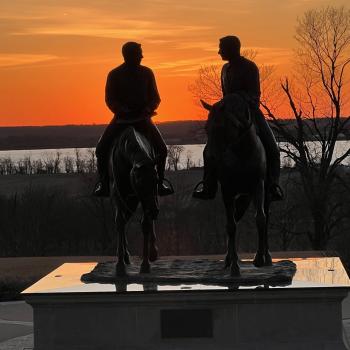
(Fair Use, from the official Church website)
***
A new “pre-print” has appeared on the website of the Interpreter Foundation:
Enoch and the Gathering of Zion: The Witness of Ancient Texts for Modern Scripture
Bradshaw, Jeffrey M. Enoch and the Gathering of Zion: The Witness of Ancient Texts for Modern Scripture. Orem, Springville, and Salt Lake City, UT: The Interpreter Foundation, Book of Mormon Central, and Eborn Books, 2021. https://interpreterfoundation.org/books/enoch-and-the-gathering-of-zion/.
Have a look at it. There’s still time to get a copy of the book before Christmas. It would be an excellent gift — both for yourself and for somebody else.
In fact, now that I’m thinking about it, any book from the Interpreter Foundation would make a wonderful Christmas gift (https://interpreterfoundation.org/books/) and so too would a copy of the DVD of the Interpreter Foundation’s theatrical film, Witnesses. Have you been stuck for gift ideas? In a panic? Growing desperate? No longer! (You’re welcome.)
And here — ’tis the season! — are links to three previous articles from Interpreter: A Journal of Latter-day Saint Faith and Scholarship:
“Latter-day Houses of the Lord: Developments in Their Design and Function,” by Richard O. Cowan
Abstract: This essay traces the modern-day usage and understanding of temples from the Kirtland Temple to Nauvoo and the Salt Lake Temple. Architecture was used to teach principles. While the Kirtland Temple was preparatory (think of the vision of Christ and the conference of keys by Abraham, Moses, Abraham, Elias, and finally Elijah), the Nauvoo Temple was dedicated to ritual usage. In 1879, the Church reduced temple usage to rituals, and thus assembly rooms are missing from later temples. Through his paper, Cowan shows how temples have changed according to revelation and how prophets have seen models in vision that then have been incorporated in the temples God’s people built.
[Editor’s Note: Part of our book chapter reprint series, this article is reprinted here as a service to the Latter-day Saint community. Original pagination and page numbers have necessarily changed, otherwise the reprint has the same content as the original.
See Richard O. Cowan, “Latter-day Houses of the Lord: Developments in Their Design and Function,” in Temple Insights: Proceedings of the Interpreter Matthew B. Brown Memorial Conference, “The Temple on Mount Zion,” 22 September 2012, ed. William J. Hamblin and David Rolph Seely (Orem, UT: The Interpreter Foundation; Salt Lake City: Eborn Books, 2014), 203–218. Further information at https://interpreterfoundation.org/books/temple-insights/.]
“Book of Abraham Polemics: Dan Vogel’s Broad Critique of the Defense of the Book of Abraham,” by Jeff Lindsay
Review of Dan Vogel, Book of Abraham Apologetics: A Review and Critique (Salt Lake City: Signature Books, 2021). 250 pp. $18.95 (softback).
Abstract: Dan Vogel’s latest book claims to offer clear-cut evidence showing what, when, and how Joseph Smith fraudulently translated the Book of Abraham. While he claims to use an objective approach, he instead weaves a polemical agenda that ignores some of the most important scholarship in favor of the Book of Abraham. He ignores crucial evidence and relies on assumptions and hypotheses as if they were established facts. The arguments of apologists, which he claims to be reviewing and critiquing, are often overlooked or, when treated, attacked without letting readers know the substance of the apologetic argument. He neglects key arguments, and important documents that don’t fit his theory. The work is a valuable tool to explore Book of Abraham polemics, but it is not even-handed scholarship by any means. Vogel’s latest contribution does not overturn the evidence against his paradigm nor overthrow the growing body of insights into the antiquity of the Book of Abraham.
Garrett R. Maxwell, “The Good God Hermeneutic: A Reconsideration of Religious Vocabulary”
Review of Fiona Givens and Terryl Givens, All Things New: Rethinking Sin, Salvation, and Everything In Between (Faith Matters Press, 2020). 188 pages. $12.95 (paperback).
Abstract: Fiona and Terryl Givens once again deliver a book worthy of the comparatively wide readership they have gained within Latter- day Saint circles. Their orderly treatment of individual gospel concepts in this book can rightly be seen as a distillation and unification of their previous work, boldly attempting to awaken us from our ignorance of the sheer novelty and vitality contained in the Restoration vision of God and humanity. They convincingly argue that the historically wrought semantic baggage that comes with the most basic religious vocabulary we use must be consciously jettisoned to fully appreciate and articulate the meaning of the Restoration.
***
I’m still thinking about the article regarding religiosity and divorce to which I’ve referred in two recent posts, here and here. A religion’s impact on behavior in the mundane world is one reasonable way of evaluating and weighing it, of course, though not directly relevant to judging its truth claims as such. Still . . .
I’m not in an especially good position or place to gather data right now, but here’s an account of a quite old study (from 1984) on the subject of divorce and Latter-day Saints: “LDS Rank High in Marriage, Low in Divorce, Study Says”
Here’s a considerably more recent but still older (2002) statement on the topic: “Statistics offer good and bad news for LDS: BYU sociologist says LDS often close to U.S. lifestyle norms”
Next, something from the year 2017: “Family Life”
And here’s the most recent account — dating to 2018, I believe — that my cursory survey has located today: “This Is Why Mormons Marry Young, And Statistics Of How It Often Ends”
And now, to conclude this hasty round of “research” (that is to say, of lazy, casual Googling), this one from way back in 1964 might still be worthy of a serious read: “Mormon and Non-Mormon Divorce Patterns,” by Phillip R. Kunz of the University of Michigan
***
I close by encouraging you to read an article by David French, one of my favorite Evangelical Protestant writers, that was kindly brought to my attention by Doug Ealy:
“The Wounds Politics Cannot Heal: Politics is a false god, and a weak god as well.”
It’s very worth reflection, at this season as at any other.
Posted from Richmond, Virginia












